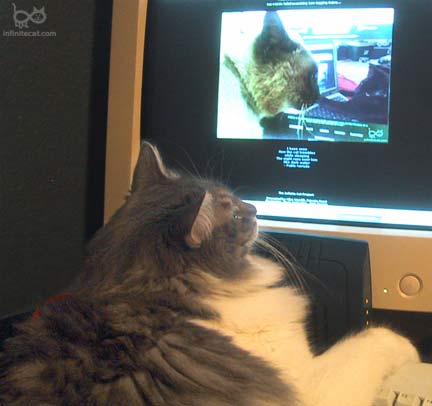| Previous Cat |  |
 |

|
Next Cat |

|
"Don't
let anyone tell you loving a cat is silly. Love, in any form, is
a precious commodity." - Barbara L. Diamond |
The Infinite Cat Project
Presented by Mike Stanfill, Private Hand
Illustration, Flash Animation, Web Design
www.privatehand.com
| How
about a refund of all premiums paid when you outlive your initial
rate guarantee period? Highly-rated life insurers such as AIG, Fidelity & Guaranty Life and Peoples Benefit Life/AEGON now offer Return-of-Premium term life. S 1. Outfit your cat with a collar and ID tag that includes your name, address, and telephone number. No matter how careful you are, there's a chance your companion may slip out the door—an ID tag greatly increases the chance that your cat will be returned home safely. 2. Follow local cat registration laws. Licensing, a registration and identification system administered by some local governments, protects both cats and people in the community. 3. Keep your cat indoors. Keeping your cat safely confined at all times is best for you, your pet, and your community. 4. Take your cat to the veterinarian for regular check-ups. If you do not have a veterinarian, ask your local animal shelter or a pet-owning friend for a referral. 5. Spay or neuter your pet. This will keep her healthier and will reduce the problem of cat overpopulation. 6. Give your cat a nutritionally balanced diet, including constant access to fresh water. Ask your veterinarian for advice on what and how often to feed your pet. 7. Train your cat to refrain from undesirable behaviors such as scratching furniture and jumping on countertops. Contrary to popular belief, cats can be trained with a bit of patience, effort, and understanding on your part. 8. Groom your cat often to keep her coat healthy, soft, and shiny. Although it is especially important to brush long-haired cats to prevent their hair from matting, even short-haired felines need to be groomed to remove as much loose hair as possible. When cats groom themselves, they ingest a great deal of hair, which often leads to hairballs. 9. Set aside time to play with your cat. While cats do not need the same level of exercise that dogs do, enjoying regular play sessions with your pet will provide him with the physical exercise and mental stimulation he needs, as well as strengthen the bond you share. 10. Be loyal to and patient with your cat. Make sure the expectations you have of your companion are reasonable and remember that the vast majority of behavior problems can be solved. If you are struggling with your pet's behavior, contact your veterinarian or local animal shelter for advice, and check out the HSUS's Pets for Life campaign information. . |